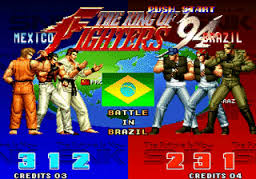Devoted to writing reviews, features, and articles about the history of Japanese gaming from 1983-present.
Monday, 7 March 2016
The History of the Neo Geo-Part 2 of 3-JGC Feature-1992-2000
Street Fighter 2 set arcades on fire in 1991. SF2 revitalized the arcade industry and solidified fighting games a valid genre. SNK caught on quick and released Garou Densetsu (Fatal Fury) to arcades in 1991. Featuring three fighters, the game was the first real challenge to the dominance of Capcom's SF2. While Garou Densetsu was certainly no match for the sheer might of SF2, it paved the way for several other high-profile SNK series to develop. Over the next few years, SNK would releases tons of 2D fighters. In 1992, SNK would release the first game in the Ryuko no Ken(Art of Fighting) series. Second-party developer ADK would soon follow with the first game in the World Heroes series in 1992. With three main fighting series, the name SNK became synonymous with the fighting genre.
During the early to mid-1990s, SNK and the Neo Geo would have several other major arcade hits on their hands. Shooter Viewpoint was one of the most impressive shooters of the time. Puzzle Bobble (Bust a Move) and its sequels were also very notable during this time period. In nearly every drive-in theatre and bowling alley, the dominating power of the Neo Geo MVS could be felt.
Sequels were abound during this time period. Garou Densetsu 2(1992), Garou Densetsu Special (1993), World Heroes 2(1993) and Ryuko no Ken 2 (1994) were all respectable sequels. However, it was Samurai Spirits (Samurai Shodown) that was the next step in the evolution of fighting games. Incorporating weapons combat in feudal Japan, the game was an instant smash at home and abroad. Samurai Spirits would see 5 sequels on the original Neo Geo hardware. In fact, the last release for the AES/MVS would be a Samurai Spirits game.
SNK had another trick up their sleeves for the Neo Geo in 1994. The King of Fighters 94 began the long-running KOF series. The series would be an annual release until 2003. KOF 1994-2003 would all be on the original AES/MVS hardware. The KOF games would find homes on the Sega Saturn, Sony PS1, Dreamcast, and PS2. In many ways, the KOF series became SNK's bread and butter.
In 1994, SNK would seek a solution to the problem of the Neo Geo's expensive cartridges. The Neo Geo CD makes its debut in 1994. Games were basically the same as the AES/MVS but with the addition of some nasty load-times. The console is famous for its lengthy load-times. Today, the Neo Geo CD is the more affordable option for casual collectors. Neo Geo CD games can be found for a fraction of the price of their AES counterparts. A second top-loading version was released soon after. As well, the CDZ featured a speedier CD drive. Despite being more approachable, the Neo Geo CD was still a niche console.
By 1996, times had changed. 2D games were starting to go the way of the dinosaur. However, SNK would have one last trick for the rapidly ageing AES/MVS hardware. Metal Slug harkened back to the "run and gun" game-play of Contra. Metal Slug would see several sequels on the AES/MVS and Neo Geo CD. Metal Slug was the last major smash for SNK and the Neo Geo. Darker days would come for SNK during the late 1990s.
After Metal Slug, SNK managed to keep with Neo Geo alive with stellar late- releases such as the Real Bout series, the underrated "Last Blade" games, and the fantastic "Garou:Mark of the Wolves". Despite some great games, times were changing. 2D games were falling out of fashion with consumers. Also, arcades soon began to die a quick death as home consoles began to keep technical pace with arcade hardware. By 2000, SNK was in deep financial trouble. In October of 2001, SNK filed for bankruptcy. One would think that this meant the end of the Neo Geo. However, the platform would remain on life support for a few more years.
Subscribe to:
Post Comments (Atom)







No comments:
Post a Comment